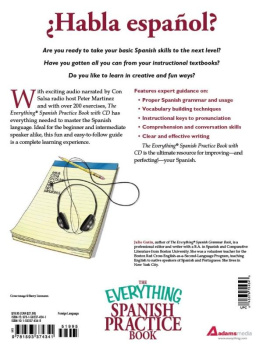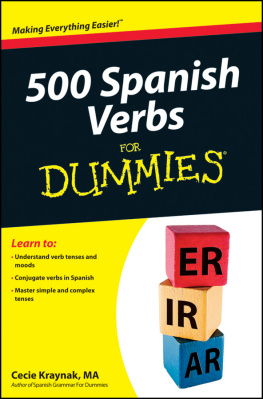Table of Contents
I dedicate this book to my good friend of more than three decades: the Argentine writer Fernando Sorrentino; his wife, Alicia; and his children, Mara Anglica, Mara Victoria, and Juan Manuel.
INTRODUCTION
Youre a busy person. You dont have the time to wade through volumes of explanation or reams of verbiage to get the specific information you need. Youve had some experience with the Spanish language, but youre a little hazy on some of the grammatical points.
You know how important the Spanish language is today, whether you travelfor business or pleasureto Latin America or Spain, or have contacts with people from those parts of the world. You are aware that approximately 350,000 people speak Spanish as their native language. You realize that today the Spanish language is extremely important right here in the United States, where it is practically an unofficial second language. For any of these reasons, you want to sharpen your skills in this important language.
You dont need a full course in Spanish. You already have a reasonably sufficient command of the vocabulary, so you dont need long word lists. Besides, you know that you never finish learning the vocabulary of any language, including your own. In addition, you know that once you have a basic vocabulary, the words you learn from there on depend on what you intend to do with the language. A full-length course in Spanish will not provide the kind of specialized vocabulary you need.
Well, then, what exactly do you need? You need a well-organized reference book that deals with the grammatical structure and syntax of the Spanish language. You want to be able to look up precisely the grammatical point that you need. You need to find this information when you need it. You dont want to have to go searching through a beginners textbookwith all the unnecessary vocabulary lists and exercisesto find what you want. Neither do you want to have to struggle with an index of a beginners textbook, hoping to find exactly the grammatical point you need, if youre lucky, when you need it.
What you need is Spanish at Your Fingertips. You want to find the specific point of grammar that you need, right when you need it. Most important: on your way to finding what youre searching for, you wont have to read anything thats not directly related to the information you want.
The author of this book is an expert in his field. He has taught Spanish for many years and knows what kind of questions students ask about the grammar of the language. In explaining the grammatical points to you, he anticipates the kind of questions you will have. His explanations are concise, uncomplicated, and down-to-earth. They are practical. Theres no wandering off on tangents, because he knows you are not interested in tangents. You want the correct answer to a very precise question. This is what you will get in this book.
This book is structured in a clear, well-organized style that uses just enough explanation to satisfy your needs. So as not to waste your time, the language is concise and to the point. This book takes what could seem like a very complicated subject and delivers it to you in clear, simple, precise terms. You will find only the most useful information about the grammatical subject you look up.
In addition to the information about the specific point you are investigating, each chapter has sidebars of two types that will help you: one type of sidebar, Words to Go, defines terms used in explaining the point of grammar.
WORDS TO...WORDS TO GO ..WORDS TO GO...
Defined words that appear in the main text of a chapter for the first time in that chapter appear in bold so you know to look for them in the sidebar. They also appear in bold at the beginning of the definition in the sidebar.
 SEE ALSO
SEE ALSO
The other type, called See Also, tells you what chapter and section to look in to find related information. You have the choice, of course, of looking up that related information or ignoring it. It all depends on your needs at the moment.
For your convenience, this book includes a glossary, with all the grammatical terms defined throughout the book. If you need to be reminded of a particular term without finding a chapter and page on which it is defined, you can simply look up the term in Appendix A, Glossary.
Appendix B, Resources, is a list of other resources that can help you improve your knowledge of Spanish. You will find a section listing dictionaries.
PRONUNCIATION
1.1 Vowels and Vowel Combinations
1.2 Consonants
1.3 The Spelling System
1.4 Accentuation (Stress) and Capitalization
1.1 VOWELS AND VOWEL COMBINATIONS
Vowels
Vowel Combinations
Vowels
The best way to learn how to pronounce a foreign language is to listen to speakers of that language, whether in person, on tape, on TV, or in films. If your television receives Spanish-language programs, you might want to listen to an hour per day of news reports or follow a soap opera. Dont be discouraged if at first you dont understand a single word! After a few weeks, as you study the language and listen to the programs, you will be able to pick out words here and there, and then more and more, until finally you understand whole sentences.
If you dont have a way to hear native speakers actually speaking Spanish, studying this chapter will help you pronounce Spanish so youll be easily understood. One factor that makes Spanish pronunciation easier to learn than English is the vowel system. Spanish has only 5 vowels, each represented by one letter of the alphabet. This differs from English, which has 9 to 13 vowels (depending on the dialect) represented by 5 letters.
In this section, you learn to pronounce the five Spanish vowels correctly.
AThe vowel represented by this letter is pronounced like the A of Ah!
EThis vowel is pronounced something like our exclamation Eh!
IThis vowel is pronounced like the EE of see.
OThis vowel is pronounced like the O of Oh!
UThis vowel is pronounced like the OO of tool.
The following table provides the letter of the alphabet, the vowel sound, a Spanish word containing this vowel, and the pronunciation of that word. The word stress is shown by uppercase letters used for the stressed syllable.
SPANISH VOWEL PRONUNCIATION
Try not to make the Spanish vowel E end with a Y sound, as in the English word say. Also avoid making the Spanish vowel O end with a W sound, as in the English word go.









 SEE ALSO
SEE ALSO

